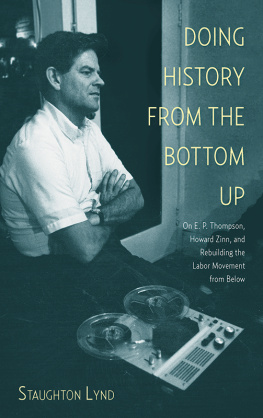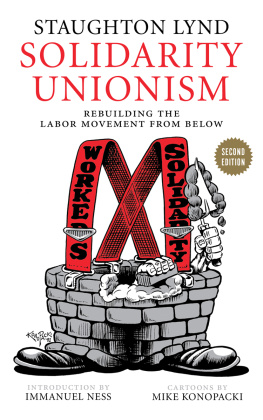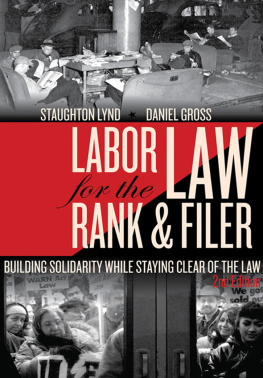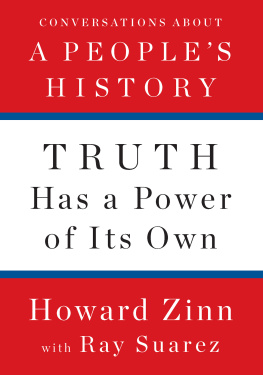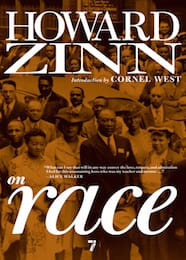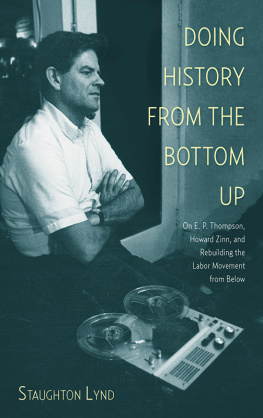Contents
Credits
All the essays that follow have been published previously with the exception of the multi-segment essay on Howard Zinn. A very few changes have been made to correct errors, a few passages that now seem of lesser importance have been omitted, and in some cases footnotes have been condensed. Permission to reprint has kindly been granted as follows:
In Memoriam: E. P. Thompson, from Living inside Our Hope: A Steadfast Radicals Thoughts on Rebuilding the Movement , copyright 1997 by Cornell University, is used by permission of the publisher, Cornell University Press.
Edward Thompsons Warrens and Guerrilla History in Gary previously appeared in From Here to There: The Staughton Lynd Reader , ed. Andrej Grubacic (Oakland, CA: PM Press, 2010) and are reprinted with permission.
The extracts from Your Dog Dont Bark No More appear in Rank and File: Personal Histories by Working-Class Organizers , ed. Alice and Staughton Lynd, expanded ed. (Chicago: Haymarket Books, 2011).
Plant Closing: Local 1330 v. U.S. Steel (19971980) appeared in American Labor Struggles and Law Histories , ed. Kenneth M. Casebeer (Durham, NC: Carolina Academic Press, 2011) and is reprinted with permission.
The Possibility of Radicalism in the Early 1930s: The Case of Steel is reprinted with permission from Workers Struggles, Past and Present: A Radical America Reader , ed. James Green (Philadelphia: Temple University Press, 1983).
We Are All Weve Got: Building a Retiree Movement in Youngstown, Ohio, by Alice Lynd and Staughton Lynd, is reprinted with permission from Law Stories , ed. Gary Bellow and Martha Minow (Ann Arbor: University of Michigan Press, 1996).
Part of chapter 3 of Solidarity Unionism: Rebuilding the Labor Movement from Below , titled Is There an Alternative to the Unionism We Have Now?, is republished with the permission of the Charles H. Kerr Publishing Company.
The introduction to We Are All Leaders: The Alternative Unionism of the Early 1930s , copyright 1996 by the Board of Trustees of the University of Illinois, is used with permission of the University of Illinois Press.
Foreword by Edward Countryman
Staughton Lynd and Doing History
Almost half a century ago Staughton Lynd published his first collection of essays, Class Conflict , Slavery, and the United States Constitution . English historian E. P. (Edward) Thompson, who (together with Howard Zinn) figures strongly in these pages, contributed the books foreword. Edward did not claim to know American historiography. But he spotted in Staughton a serious fellow practitioner of hard research, careful reasoning about what the research revealed, and caring about what difference knowing history makes.
By the time he published Class Conflict , Staughton had gained fame for his commitment to civil rights and his opposition to the war in Vietnam. Despite his academic record (which included being one of the few historians to write a masters essay that deserved publication as a book), Staughtons politics were too much for the administrators at Yale, who denied him tenure. This was shortly after Edward joined the University of Warwick, which drove him out for political reasons five years after Class Conflict appeared in print.
Outside the academy, their paths seemed to diverge. Thanks to Dorothy Thompsons position at the University of Birmingham and to visits both of them made to American campuses, Edward was able to keep writing at a furious pace, producing fine historical work and a huge body of political commentary. He gained world fame as an opponent of the Reagan-Thatcher-Brezhnev nuclear buildup, when supposedly responsible statesmen and planners were talking about survivable nuclear war. I was among a quarter-million people who heard him in Londons Hyde Park. I remember a half-facetious sign on that demonstration that read Historians Against the Bomb: We Demand a Continuing Supply of History. Edward could be contentious, and he quarreled as strongly with notable supposed allies as he did with outright political opponents. His death in 1993 was front-page and prime-time UK news.
Staughton went to law school, not with the goal of making a lot of money but with the clear realization that there was practical hard work to do among and for working people in what used to be the American republics industrial heartland and now is its Rust Belt. When he and Alice Lynd retired from employment as lawyers in 1996, they turned their attention to the obscenity that is the American prison system. Though they are in their eighties, they have not let up to this day, most recently taking on the cause of hunger strikers at Menard Correctional Center in Southern Illinois, where, it happens, I call one of the inmates my friend.
But like Edward Thompson, Staughton Lynd continued to write. Doing History is the thirtieth book that he has written, cowritten, or edited. I first encountered his writing at Manhattan College, thanks to my teacher Bob Christen, who had been Staughtons graduate school colleague at Columbia and who amassed his own superb record in the public sphere. (In my naivet I was amazed to see Staughton thanking Bob in the preface to his masters essay.) But I did not meet Staughton until a remarkable group of historians interested in American radicalism gathered at a dude ranch in Montana early in this millennium. Long-ago colaborers in early American history writing were there, most notably Alfred F. Young, and so were younger scholars. Al encouraged Staughton to return to a manuscript he had set aside when his academic life ended, which Staughton and historian David Waldstreicher published together in the prestigious William and Mary Quarterly .Exile and blacklisting need not be forever.
But Staughton never acted like an exile. He left the academy, but he went on doing history in all senses of this books title. He did history by making it with the cases that he and Alice took to court. He did history by observing others make it: the people all around him who were struggling against the rolling destruction that impersonal corporations were wreaking on lives, jobs, communities, and a whole way of life across the industrial American Midwest. He did history by gathering their stories so that the record of what happened and what working people thought, said, and did while most of the American steel industry was being gutted would be preserved. He did history by pondering what he was learning from them. He does history in all of these senses in the long second part of this book.
What he writes is not just the story of what happened as Big Steel went down in Youngstown and during the Little Steel struggles in Indiana. Its also a reflection on what was possible, in terms that go beyond the usual stuff of labor history. The field currently is unfashionable; it badly needs to come back to life. Thats partly for the sake of understanding how industrial capitalist America has given way to the onslaught of service, information, and high-finance capitalist America, where the needs, powers, and utter lack of social responsibility on the part of corporations seem to know no limit. But its also for the sake of asking what is to be done, particularly in view of what the mainstream unions have and have not done, can and cannot do on behalf of the people who make them up. He presents a searing indictment not only of often self-serving union leadership but of the whole structure of labor-management relations that took shape during the New Deal.
That structure, centered on contracts and the National Labor Relations Board, has been under a ferocious onslaught ever since Ronald Reagan broke the strike of air traffic controllers early in his first presidential term. The onslaught continues. Boeing has taken advantage of the legal inability of the International Association of Machinists to strike while a contract is in force, in order to impose poorer conditions on new workers on its 777 production line in Seattle. Republican politicians in Tennessee have deployed outright threats against both Volkswagen and its Chattanooga workforce to defeat an organizing drive by the United Auto Workers. Behemoth retailers including (but not limited to) Walmart, Whole Foods, Amazon.com, and the whole fast-food sector make enormous efforts to keep unions out of their stores and their gargantuan warehouses.
Next page
